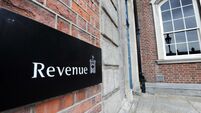Closure highlights anomaly of Vatican’s dual claim
Benedict XVI delivers an Easter address at St Peter’s Square in the Vatican, which occupies 108 acres in the heart of Rome. Picture: AP Photo/L’Osservatore Romano
A GOOD deal of nonsense has been written about the Government’s decision to close the Irish embassy to the Holy See — much of it based on an unwillingness to distinguish between a global church and a claim by the headquarters of this Church (the Vatican) to be a sovereign state.
















